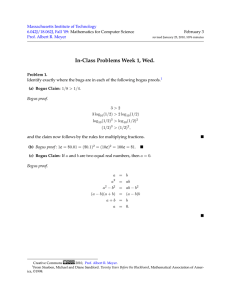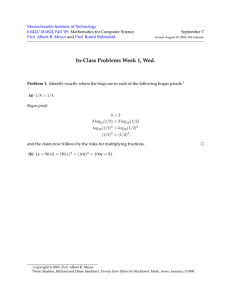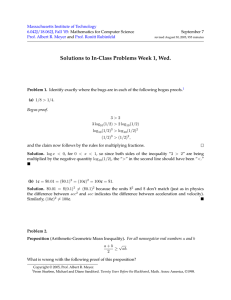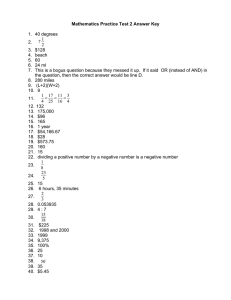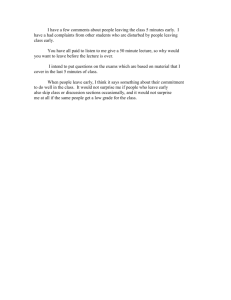Document 13440915
advertisement
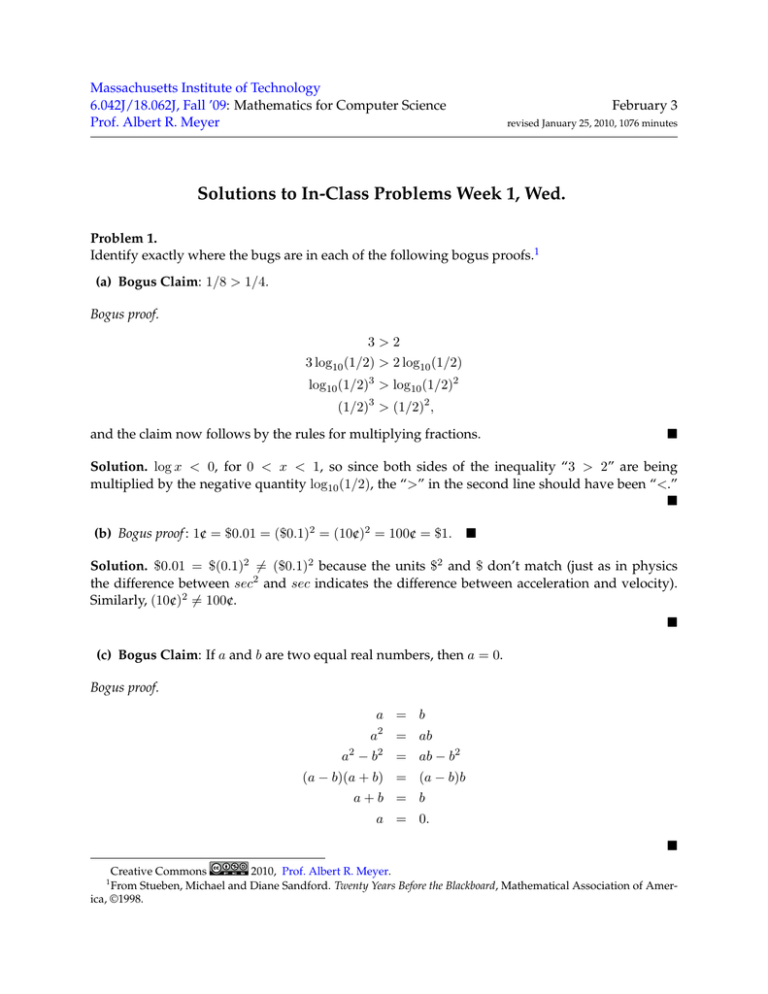
Massachusetts Institute of Technology 6.042J/18.062J, Fall ’09: Mathematics for Computer Science Prof. Albert R. Meyer February 3 revised January 25, 2010, 1076 minutes Solutions to In-Class Problems Week 1, Wed. Problem 1. Identify exactly where the bugs are in each of the following bogus proofs.1 (a) Bogus Claim: 1/8 > 1/4. Bogus proof. 3 > 2 3 log10 (1/2) > 2 log10 (1/2) log10 (1/2)3 > log10 (1/2)2 (1/2)3 > (1/2)2 , and the claim now follows by the rules for multiplying fractions. � Solution. log x < 0, for 0 < x < 1, so since both sides of the inequality “3 > 2” are being multiplied by the negative quantity log10 (1/2), the “>” in the second line should have been “<.” � (b) Bogus proof : 1¢ = $0.01 = ($0.1)2 = (10¢)2 = 100¢ = $1. � Solution. $0.01 = $(0.1)2 �= ($0.1)2 because the units $2 and $ don’t match (just as in physics the difference between sec2 and sec indicates the difference between acceleration and velocity). Similarly, (10¢)2 �= 100¢. � (c) Bogus Claim: If a and b are two equal real numbers, then a = 0. Bogus proof. a = b a2 = ab a2 − b2 = ab − b2 (a − b)(a + b) = (a − b)b a+b = b a = 0. � Creative Commons 2010, Prof. Albert R. Meyer. From Stueben, Michael and Diane Sandford. Twenty Years Before the Blackboard, Mathematical Association of Amer­ ica, ©1998. 1 2 Solutions to In-Class Problems Week 1, Wed. Solution. The bug is at the fifth line: one cannot cancel (a − b) from both sides of the equation on the fourth line because a − b = 0. � Problem 2. It’s a fact that the Arithmetic Mean is at least as large the Geometric Mean, namely, a+b √ ≥ ab 2 for all nonnegative real numbers a and b. But there’s something objectionable about the following proof of this fact. What’s the objection, and how would you fix it? Bogus proof. a+b ? √ ≥ ab, 2 ? √ a + b ≥ 2 ab, ? a2 + 2ab + b2 ≥ 4ab, ? a2 − 2ab + b2 ≥ 0, 2 (a − b) ≥ 0 so so so so which we know is true. The last statement is true because a − b is a real number, and the square of a real number is never negative. This proves the claim. � Solution. In this argument, we started with what we wanted to prove and then reasoned until we reached a statement that is surely true. The little question marks presumably are supposed to indicate that we’re not quite certain that the inequalities are valid until we get down to the last step. At that step, the out, but that doesn’t prove the claim. All we have proved is √ inequality checks 2 that if (a + b)/2 ≥ ab, then (a − b) ≥ 0, which is not very interesting, since we already knew that the square of any nonnegative number is nonnegative. To be fair, this bogus proof is pretty good: if it was written in reverse order – or if “is implied by” was simply inserted after each line – it would actually prove the Arithmetic-Geometric Mean Inequality: Proof. a+b √ ≥ ab 2 √ a + b ≥ 2 ab, a2 + 2ab + b2 ≥ 4ab, 2 2 a − 2ab + b ≥ 0, is implied by which is implied by which is implied by which is implied by 2 (a − b) ≥ 0. The last statement is true because a − b is a real number, and the square of a real number is never negative. This proves the claim. � Solutions to In-Class Problems Week 1, Wed. 3 But the problem with the bogus proof as written is that it reasons backward, beginning with the proposition in question and reasoning to a true conclusion. This kind of backward reasoning can easily “prove” false statements. Here’s an example: Bogus Claim: 0 = 1. Bogus proof. 0 = 1, ? so ? 1 = 0, so ? so 0 + 1 = 1 + 0, 1=1 which is trivially true, which proves 0 = 1. � We can also come up with very easy “proofs” of true theorems, for example, here’s an easy “proof” of the Arithmetic-Geometric Mean Inequality: Bogus proof. a+b ? √ ≥ ab, 2 √ a+b ? 0· ≥ 0 · ab, 2 0≥0 so so which is trivially true. � So watch out for backward proofs! � Problem 3. Albert announces that he plans a surprise 6.042 quiz next week. His students wonder if the quiz could be next Friday. The students realize that it obviously cannot, because if it hadn’t been given before Friday, everyone would know that there was only Friday left on which to give it, so it wouldn’t be a surprise any more. So the students ask whether Albert could give the surprise quiz Thursday? They observe that if the quiz wasn’t given before Thursday, it would have to be given on the Thursday, since they already know it can’t be given on Friday. But having figured that out, it wouldn’t be a surprise if the quiz was on Thursday either. Similarly, the students reason that the quiz can’t be on Wednesday, Tuesday, or Monday. Namely, it’s impossible for Albert to give a surprise quiz next week. All the students now relax, having concluded that Albert must have been bluffing. And since no one expects the quiz, that’s why, when Albert gives it on Tuesday next week, it really is a surprise! What do you think is wrong with the students’ reasoning? 4 Solutions to In-Class Problems Week 1, Wed. Solution. The basic problem is that “surprise” is not a mathematical concept, nor is there any generally accepted way to give it a mathematical definition. The “proof” above assumes some plausible axioms about surprise, without defining it. The paradox is that these axioms are incon­ sistent. But that’s no surprise :-), since —mathematically speaking —we don’t know what we’re talking about. Mathematicians and philosophers have had a lot more to say about what might be wrong with the students’ reasoning, (see Chow, Timothy Y. The surprise examination or unexpected hanging paradox, American Mathematical Monthly (January 1998), pp.41–51.) � MIT OpenCourseWare http://ocw.mit.edu 6.042J / 18.062J Mathematics for Computer Science Spring 2010 For information about citing these materials or our Terms of Use, visit: http://ocw.mit.edu/terms.
